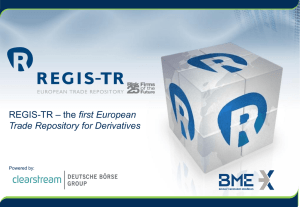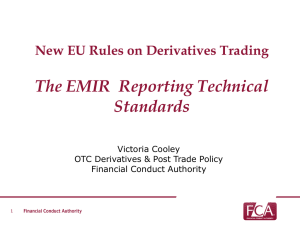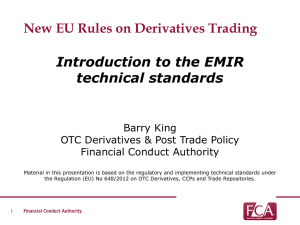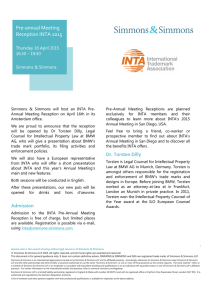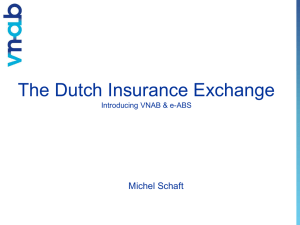Derivatives legislation and litigation
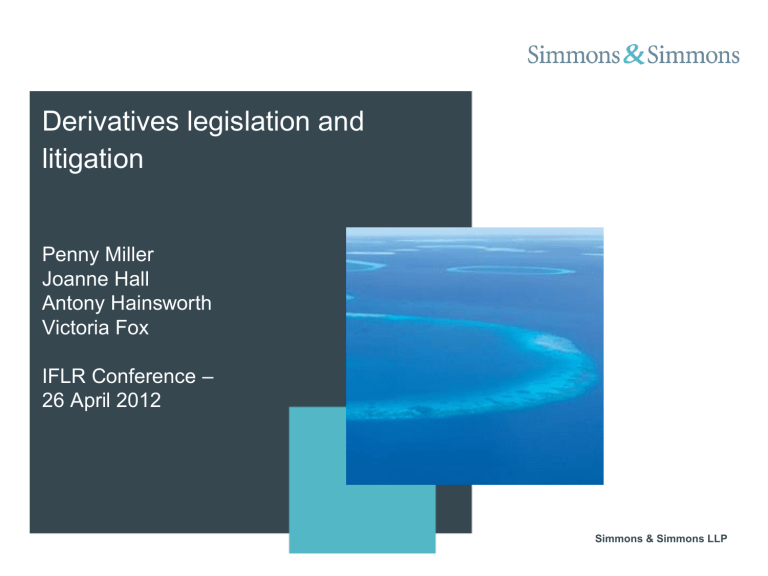
Derivatives legislation and litigation
Penny Miller
Joanne Hall
Antony Hainsworth
Victoria Fox
IFLR Conference –
26 April 2012
Simmons & Simmons LLP
What we will cover – Derivatives regulation and litigation
EMIR
–
Overview of EMIR and practical considerations for firms
Extraterritoriality
– International co-ordination and consistency of OTC derivatives reform –
EMIR, Dodd Frank and beyond
Section 2(a)(iii) of the ISDA Master Agreement
– Impact of client litigation in relation to Section 2(a)(iii)
© Simmons & Simmons 2010
2 / Doc ID: L_LIVE_EMEA1:12533443v1
G20 statement in Pittsburgh
“All standardized OTC derivative contracts should be traded on exchanges or electronic trading platforms, where appropriate, and cleared through central counterparties by end-2012 at the latest. OTC derivative contracts should be reported to trade repositories. Non-centrally cleared contracts should be subject to higher capital requirements.
”
September 2009
© Simmons & Simmons 2010
3 / Doc ID: L_LIVE_EMEA1:12533443v1
What we will cover – territorial scope
EU
EMIR
MiFID2
US
Dodd Frank
Asia
Hong Kong
Singapore
Korea
© Simmons & Simmons 2010
4 / Doc ID: L_LIVE_EMEA1:12533443v1
What we will cover - clearing and exchange-trading
EMIR Clearing obligation
Clearing obligation
Reporting obligation
Risk mitigation for uncleared trades
Requirements for CCPs and trade repositories
MiFID2/MiFIR
Exchange trading
© Simmons & Simmons 2010
5 / Doc ID: L_LIVE_EMEA1:12533443v1
Timeline - EMIR
Level 1 text
March 2012
- Finalised text expected Q2 2012
Level 2 measures – discussion papers so far
ESMA: reporting obligation, mandatory clearing obligation, requirements for CCPs and risk mitigation of uncleared trades
EBA: capital requirements for CCPs
EBA/ESA: margin requirements for uncleared trades
Level 2 measures – the future
-Further consultation Q2/Q3 2012
© Simmons & Simmons 2010
6 / Doc ID: L_LIVE_EMEA1:12533443v1
Level 2 measures
– final versions
- Binding technical standards finalised by September 2012
- Introduced by end of 2012
The clearing obligation
© Simmons & Simmons 2010
7 / Doc ID: L_LIVE_EMEA1:12533443v1
How central clearing works – Dealer to Dealer Clearing
Bilateral OTC
Market
Dealer 1
Dealer 2
Centrally
Cleared Market
Dealer 1
‘Novation’
CCP
Dealer 2
In central clearing, each dealer ‘gives up’ / ‘novates their half of the trade to the CCP. The CCP has credit exposure to each party against which it takes margin: the dealers have none to each other.
For each trade the CCP has with a Dealer it will have an off-setting trade with another Dealer.
© Simmons & Simmons 2010
8 / Doc ID: L_LIVE_EMEA1:12533443v1
How central clearing works – client clearing
Client 1
Bilateral OTC
Market
Dealer 4
Dealer 1
Dealer 2
Dealer 3
Client 1
Clearing
Arrangement
Centrally
Cleared Market
Clearing member
Dealer 2
CCP
Dealer 4
Dealer 3
Most Clients who are not large dealers cannot (or will not want to) face the CCP as a clearing member so they will use a Clearing Member to clear for them.
© Simmons & Simmons 2010
9 / Doc ID: L_LIVE_EMEA1:12533443v1
How central clearing works – Default of a Clearing Member
CCP closes out
Clearing Member’s house positions & uses margins and/or default fund contributions to cover losses
It is vitally important that the Clearing
House is financially robust
Bank F
Clearing member
Bank A
Clearing member
Bank E
Clearing member
CCP
Bank B
Clearing member
Bank D
Clearing member
Bank C
Clearing member
Client 1
Default Protected from direct losses due to clearing membership
© Simmons & Simmons 2010
10 / Doc ID: L_LIVE_EMEA1:12533443v1
How central clearing works – Default of a Clearing Member
Client positions will either be:
–
Ported to another Clearing Member
– ability to port will depend on level of segregation chosen by Client
– Liquidated – margin returned directly to Client by CCP if suitable protections in place
Default of a Client will be handled by Clearing Member
© Simmons & Simmons 2010
11 / Doc ID: L_LIVE_EMEA1:12533443v1
How will a product become subject to mandatory clearing?
ESMA can determine that a contract already cleared by a CCP is subject to mandatory clearing (bottom-up approach)
ESMA can determine a product must be cleared (top-down approach)
Once mandatory clearing enforced, all newly executed contracts of the determined type must be cleared
Frontloading: contracts entered into after bottom-up process begins but before mandatory clearing takes effect must also be cleared
© Simmons & Simmons 2010
12 / Doc ID: L_LIVE_EMEA1:12533443v1
What products will become subject to mandatory clearing?
Standardised and liquid enough to warrant mandatory clearing
Overarching aim of clearing is to reduce systemic risk.
Eligibility considerations:
– Standardisation of contractual terms and operational procedures
– Volume and liquidity of contracts
– Availability of fair, reliable and generally accepted pricing information
Structured/complex OTC Trades will not be subject to clearing but will be subject to risk mitigation for uncleared trades
© Simmons & Simmons 2010
13 / Doc ID: L_LIVE_EMEA1:12533443v1
Which entities are subject to mandatory clearing?
Financial counterparties
Non financial counterparties above clearing threshold
Third country entities equivalent to above
Threshold to be set by ESMA in forthcoming regulatory technical standards
Transactions designed to reduce risks to commercial activity or treasury financing activity do not count towards clearing threshold
© Simmons & Simmons 2010
14 / Doc ID: L_LIVE_EMEA1:12533443v1
EU – The clearing obligation
Financial counterparty
Financial counterparty
Non financial counterparty exceeding threshold
Financial counterparty
Non financial counterparty exceeding threshold
Financial counterparty
Non financial counterparty exceeded threshold
Non financial counterparty exceeding threshold
Third country entity that would be subject to clearing if in EU
Third country entity that would be subject to clearing if in EU
Two entities established in third countries would be subject to clearing obligation if they were in the EU provided the contract has a “direct, substantial and foreseeable effect within EU”.
© Simmons & Simmons 2010
15 / Doc ID: L_LIVE_EMEA1:12533443v1
Other exemptions
Sovereigns/MDBs
– Non-EU sovereigns to be determined by ESMA
Pension funds
–
Will not apply until a suitable technical solution for transfer of non-cash collateral as variation margin is developed by CCPs
– Ultimate aim is to have central clearing as soon as tenable
– Transitional arrangements
Intra-group
– an intra-group transaction will apply if entity is part of the same group provided that the counterparties are included in the same consolidation on a full basis and they are subject to an appropriate centralised risk evaluation, measurement and control procedures and that counterparty is established in the Union or, if it is established in a third country, the Commission has adopted an implementing act
FX
–
ESMA can decide not to require clearing of certain FX transactions
© Simmons & Simmons 2010
16 / Doc ID: L_LIVE_EMEA1:12533443v1
The perceived benefits and risks of central clearing
Potential benefits Risks
Reduced systemic risk
Reduced counterparty credit risk
Cleared trades will attract favourable risk weighting and hence reduce capital charge for most counterparties
(NB risk weightings against default fund)
Better transparency
Orderly Default Management
Possibility of portability may reduce failure
© Simmons & Simmons 2010
17 / Doc ID: L_LIVE_EMEA1:12533443v1
Concentration Risk
Netting efficiency - reduced netting benefit across products reduced further if more
CCPs
Capitalisation issues
– limited number of entities able to satisfy CCP membership requirements
Race to the bottom
The reporting obligation
© Simmons & Simmons 2010
18 / Doc ID: L_LIVE_EMEA1:12533443v1
The reporting obligation
All entities
Reporting obligation of all derivatives Registered trade repository
A database to provide transparency
Currently organised per asset class
Examples: DTCC and Regis-TR for multiple asset classes, ICE
Trade Vault for commodities
© Simmons & Simmons 2010
19 / Doc ID: L_LIVE_EMEA1:12533443v1
The reporting obligation
Information to be reported to TRs:
– the parties to the contract (or the beneficiary)
– type of contract
– maturity
– notional value
– price
– settlement date
Reduces duplication by taking account of:
– MiFID transaction reporting
– REMIT reporting requirements
© Simmons & Simmons 2010
20 / Doc ID: L_LIVE_EMEA1:12533443v1
Practical consideration
Who reports?
– Both counterparties can report the same trade
–
By prior arrangement, one party can report on behalf of both counterparties
– A third-party (such as a CCP or trading platform)
What must be reported?
– All exchange and OTC derivative trades
–
Intragroup trades
– Trades with retail investors
–
Trades with non-financial counterparties
Details of new contracts will need to be reported by the end of the business day following execution
Backloading – previously executed but still active contracts will also need to be reported by a specified date (likely late 2013 or early 2014)
© Simmons & Simmons 2010
21 / Doc ID: L_LIVE_EMEA1:12533443v1
Risk mitigation for uncleared trades
© Simmons & Simmons 2010
22 / Doc ID: L_LIVE_EMEA1:12533443v1
Risk mitigation for non-cleared trades
Contracts will be subject to risk mitigation if they:
–
Are not eligible for clearing, or
– Are transacted between counterparties at least one of which is not required to clear
– will be subject to risk mitigation
Limited exemptions for intra-group transactions
Detailed risk mitigation requirement to be set out in regulatory technical standards developed by ESMA and the other European Supervisory Authorities
(ESAs)
© Simmons & Simmons 2010
23 / Doc ID: L_LIVE_EMEA1:12533443v1
Requirements for risk mitigation
EMIR refers to certain basic requirements for financial counterparties and nonfinancial counterparties above clearing threshold:
– Exchange of collateral
– Holding of capital to cover risks not covered by exchange of collateral
– Electronic confirmations
– Portfolio reconciliation
– Daily marking to market
– Where not possible, prudent marking to model
– Dispute resolution mechanisms
© Simmons & Simmons 2010
24 / Doc ID: L_LIVE_EMEA1:12533443v1
Key current issues – ESA papers
Initial Margin
Collateral provided to cover potential future exposures arising from relevant transactions in interval between last exchange of margins and liquidation of relevant positions
Variation margin
Collateral exchanged between counterparties to reflect exposures resulting from actual changes in value of relevant transaction
Variation margin likely to be exchanged; initial margin under consideration
© Simmons & Simmons 2010
25 / Doc ID: L_LIVE_EMEA1:12533443v1
Exchange trading/position limits
© Simmons & Simmons 2010
26 / Doc ID: L_LIVE_EMEA1:12533443v1
Exchange trading of OTC derivatives – MiFID/MIFIR
Financial counterparties and non-financial counterparties exceeding a threshold required to transact certain derivatives on:
–
Regulated markets (RMs)
– Multilateral trading facilities (MTFs)
–
Organised trading facilities (OTFs)
– Non EU trading venues that Commission determines are equivalent to EU trading venues (unless non-EU country does not provide equivalent reciprocal recognition of
EU trading venues)
Trading obligation will also apply to:
– Counterparties who enter into derivatives with third country financial institutions or other entities that would be the subject of clearing obligation if they were established in the EU
– Contracts as between two third country entities, if contract has a direct, substantial and foreseeable effect within the EU or where a trading obligation is necessary to prevent evasion of MiFIR
© Simmons & Simmons 2010
27 / Doc ID: L_LIVE_EMEA1:12533443v1
Additional information?
See our Regulatory Revolution Tracker on EMIR which includes commentary on the EMIR regime
© Simmons & Simmons 2010
28 / Doc ID: L_LIVE_EMEA1:12533443v1
IFLR Capital Markets Forum
International coordination and consistency of
OTC derivatives reform
– EMIR, Dodd-Frank and beyond
26 April 2012
Antony Hainsworth, CIB Legal - European Regulatory Affairs
International coordination – Beginning with the G20
• The roots of OTC derivatives reform under EMIR, Dodd-
Frank and other initiatives lie in the commitments agreed by international leaders at the Pittsburgh summit of the G20 in September, 2009 .
• The agreement of a common set of regulatory commitments was designed to avoid regulatory arbitrage and avoid a “race to the bottom” in the creation of new laws and regulations applicable to OTC derivatives.
• The key commitments were:
• “ All standardized OTC derivative contracts should be traded on exchanges or electronic trading platforms , where appropriate, and cleared through central counterparties by end-2012 at the latest.
•
•
OTC derivative contracts should be reported to trade repositories .
Non-centrally cleared contracts should be subject to higher capital requirements.”
• The communique also added that
“[w]e ask the FSB and its relevant members to assess regularly implementation and whether it is sufficient to improve transparency in the derivatives markets, mitigate systemic risk, and protect against market abuse .”
30
International coordination – The role of the FSB
• Financial Stability Board (the “ FSB ”) was established in April 2009 as a successor to the
Financial Stability Forum (which began as a G7 body before its membership was extended to other countries).
• The FSB describes its own mandate as follows: “ The FSB has been established to coordinate at the international level the work of national financial authorities and international standard setting bodies and to develop and promote the implementation of effective regulatory, supervisory and other financial sector policies. It brings together national authorities responsible for financial stability in significant international financial centres, international financial institutions, sector-specific international groupings of regulators and supervisors, and committees of central bank experts.
”
• In this context, the FSB has been tasked with monitoring the progress of the G20’s regulatory reform agenda.
• In its October 2011 progress report on OTC derivatives reform, the FSB reported that “ with only just over one year until the end-2012 deadline for implementing the G20 commitments, few FSB members have the legislation or regulations in place to provide the framework for operationalising the commitments.
While recognising the implementation challenges and the complexity of the needed laws and regulations, the report concludes that jurisdictions should aggressively push forward to meet the G-20 end-2012 deadline in as many reform areas as possible.”
31
International coordination – Where we are now
United States – First past the post (but implementation work continues)
•Ongoing work on definitions (e.g. swap / swap dealer)
•Uncertainty over application to non-US firms
•Sets up a potential battle over trade infrastructure (clearing houses, SEFs, etc). Where will international business end up being executed / cleared?
Australia – Initial legislative framework only published this week
The Australian Council of Financial
Regulators (the Council) issued a discussion paper in mid 2011 looking at central clearing of OTC derivatives in the domestic market. Interestingly, the
Council noted in its report that OTC derivatives were more relevant for
Europe and the US, given the size of their OTC markets.
On April 18, 2012, The Treasury published a formal consultation with details of a proposed legislative framework.
Hong Kong –Legislative proposal shows willing
•The Hong Kong Monetary Authority (the “
HKMA
”) have confirmed that the territory will “ tentatively” introduce centralised clearing and reporting for OTC derivatives in January 2013. A joint consultation by the HKMA and the Securities and Futures
Authority ended in November, 2011.
•The principal legislative changes necessary will be implemented through amendments to the Securities and Futures Ordinance
(the “
SFO
”).
Europe – On course for the G20 deadline (but many details still to be refined)
•Indirect clearing recognised – but what will this mean for clearing in practice?
•The role of ESMA in recognition of 3 rd country trade infrastructure (e.g. CCPs).
•Application to transactions with firms that would have been subject to the clearing obligation if established in Europe.
Singapore – Consultations show an interest (but behind in timetabling terms)
•The Monetary Authority of Singapore
(the “
MAS
”) published a consultation on proposed regulation of OTC derivatives in February. The consultation closed in
March, just over a month later.
Non-G20 – Will other countries follow suit?
•Saudi Arabia is a G20 economy, but a number of other key nations with institutions active in derivatives business (e.g. Norway and the UAE) are not.
•Note some other nations (e.g. Netherlands and Spain) participate indirectly only, e.g. through the EU.
32
International coordination – Key 3
rd
country issues
• Territorial scope – Does the local legislation apply to overseas institutions and, if so, in what circumstances?
e.g. 722(d) of DoddFrank Act provides that “[ t]he provisions of this Act relating to swaps… shall not apply to activities outside the United States unless those activities: (1) have a direct and significant connection with activities in, or effect on, commerce of the United States; or (2) contravene such rules or regulations as the Commission may prescribe or promulgate as are necessary or appropriate to prevent the evasion of any provision of this Act….
’’
Contrast this restriction to EMIR, which does not contain any general restriction on territorial scope, but does include a number of territorial restrictions in the core provisions and definitions, e.g. the term “financial counterparty” is defined exhaustively with reference to existing European legislation (e.g. MiFID, Banking Consolidation Directive, etc).
• Treatment of cross-border transactions – What happens when a local entity wants to enter into a transaction with an entity based overseas?
e.g. The clearing obligation under Article 4 of EMIR will still apply in certain cases where EU financial counterparties (and non-financial counterparties over the clearing threshold) face non-EU counterparties, including an entity established in a third country that would be subject to the clearing obligation if it were established in the Union . In addition, the obligation will apply
“ between two entities established in one or more third countries that would be subject to the clearing obligation if they were established in the Union, provided that the contract has a direct, substantial and foreseeable effect within the Union or where such an obligation is necessary or appropriate to prevent the evasion of any provisions of this Regulation .”
Contrast this provision to Dodd-Frank, which does not afford non-US entities any express carveout from key definitions and in some cases (e.g. the definition of “major swap participant”) may expressly bring non-US entities into scope.
CFTC Chairman Gary Gensler has expressly recognised the possibility of a “phased” implementation for non-US firms (e.g. as regards the requirement for swap dealer registration), but the lack of concrete action on this point has attracted criticism, including an open letter from Commissioner Barnier, published last week.
33
International coordination – Key 3
rd
country issues
• Recognition of 3 rd country market infrastructure – Under what circumstances will 3 rd country infrastructure (e.g. a third country CCP) be recognised as satisfying local requirements, e.g. where an
EU entity wants to clear a transaction over a US CCP?
EMIR tackles the issue head-on . For example, Article 25 sets out the process for the European Securities and Markets
Authority (“ ESMA ”) to recognise a third country CCP. The requirements for recognition include that the CCP is subject to effective supervision and enforcement ensuring a full compliance with the prudential requirements applicable in that third country; that there are cooperation arrangements between ESMA and the authority responsible for overseeing the relevant
CCP; and that the CCP is established or authorised in a third country that is considered as having equivalent AML/CFT systems to the Union. Elsewhere, Article 77 contains requirements on recognition of third country trade repositories.
DoddFrank introduces a new concept of financial market utility (“ FMU ”), which is defined as “ any person that manages or operates a multilateral system for the purpose of transferring, clearing, or settling payments, securities, or other financial transactions among financial institutions or between financial institutions and the person .” The definition of FMU will include derivatives clearing organisations (“ DCOs ”) as a subset.
Some third country entities (e.g. LCH.Clearnet) have registered as DCOs, even though this area of the act is not yet fully implemented. LCH’s clearing of interest-rate swaps, for example, pre-dated Dodd-Frank. In its application to register as a
DCO with the SEC, LCH publicly confirmed to the SEC that the CFTC already reviews LCH’s clearing systems and mechanics, margin requirements and calculations and its compliance procedures (noting that US regulators’ role with respect to oversight of LCH will become more substantial once the Dodd-Frank Act is fully effective).
Whilst the recognition of third country market infrastructure is important to prevent fragmentation , consistency of rulemaking will remain important. This will equally apply looking forward to execution requirements (which Dodd-Frank tackles under the provisions on SEFs, but which Europe will only address under MiFID II / MiFIR , currently being negotiated and due to come into force 2013 – 2014 .
34
International coordination – Thank-you
Thanks for listening.
Antony Hainsworth, CIB Legal - European Regulatory Affairs antony.hainsworth@uk.bnpparibas.com
+44(0)207 5952174
35
Recent derivatives litigation: useful clarity on key provisions
Victoria Fox
Barclays
April 2012
Section 2(a)(iii) of the ISDA Master Agreement
Each obligation of each party under Section 2(a)(i) [obligation to make payments and deliveries] is subject to (1) the condition precedent that no Event of Default or Potential Event of Default with respect to the other party has occurred and is continuing, (2) the condition precedent that no Early Termination Date in respect of the relevant Transaction has occurred or been effectively designated and (3) each other condition precedent specified in this Agreement to be a condition precedent for the purpose of this Section 2(a)(iii).
37 | Litigation on Section 2(a)(iii) | April 2012
Purpose of the condition precedent
• After an Event of Default, Non-defaulting Party (NDP) may designate an Early Termination Date, after which the market value of the transactions will be paid
• Payments under the ISDA are netted if due on the same day, in the same currency and (sometimes) under the same transaction
• 2(a)(iii) prevents Non-defaulting Party (NDP) from paying away money in circumstances where a counterparty has defaulted but the
ISDA has not terminated
• What if the Defaulting Party (DP) becomes insolvent when the ISDA is in-the-money to it?
38 | Litigation on Section 2(a)(iii) | April 2012
Conflicting decisions in lower courts
• Metavante (2009US): NDP’s right to withhold payment constitutes an ipso facto provision that is unenforceable under US Bankruptcy Code.
Right to terminate is not indefinite – failure to do so after a year constitutes a waiver
• Marine Trade v Pioneer (2010): 2(a)(iii) is a one-time test – if not satisfied on the payment date, the payment obligation never arises even if the default is subsequently cured
• Lomas v Firth Rixson (2011): suspended payment obligations are extinguished at the scheduled termination date of the transactions;
NDP can only enforce the net obligation of the DP
• Pioneer v Cosco (2011): NDP can enforce the gross (rather than net) obligations of the DP
• Pioneer v TMT (2011): NDP can only enforce the net obligation of the
DP
39 | Litigation on Section 2(a)(iii) | April 2012
Useful clarity from the Court of Appeal
NDP’s payment obligation is suspended (not extinguished) while a default is continuing; it will revive if the default is cured, even if after maturity
NDP can rely indefinitely upon 2(a)(iii)
If the ISDA is terminated after maturity of the transactions, any payments that would otherwise have been due should be taken into account when calculating termination payment
NDP can only enforce for the net payment due from the DP; payment netting applies prior to application of the condition precedent
(on the facts) 2(a)(iii) does not offend the anti-deprivation or pari passu principles
40 | Litigation on Section 2(a)(iii) | April 2012
Open issues
Notwithstanding court decisions, 2(a)(iii) is not safe
– May prevent orderly resolution of failing instititution
– December 2009: UK Treasury consultation called on ISDA to address “uncertainty”
ISDA and market working on a proposal to amend 2(a)(iii) into a “use it or lose it” provision
– Debate over how long NDP should have
What about mandatory set-off under Insolvency Rules?
Approach in other jurisdictions
– Metavante creates uncertainty for US counterparties; US regulators may follow the UK approach
– Rest of the world?
41 | Litigation on Section 2(a)(iii) | April 2012
Contact details
Penny Miller
Managing Associate
T +44 20 7825 3532
E penny.miller@simmons-simmons.com
Joanne Hall
Director
T +44 20 7568 1522
E joanne.hall@ubs.com
Antony Hainsworth
CIB Legal
T +44 20 7595 2174
E antony.hainsworth@uk.bnpparibas.com
Victoria Fox
Director
T +44 20 7773 4704
E victoria.fox@barclays.com
© Simmons & Simmons 2010
42 / Doc ID: L_LIVE_EMEA1:12533443v1
simmons-simmons.com
elexica.com
© Simmons & Simmons 2010
43 / Doc ID: L_LIVE_EMEA1:12533443v1
